Pb(Er1/2Nb1/2)O3–Pb(Zn1/3Nb2/3)O3–PbTiO3 Single Crystals with High Curie Temperature
Abstract
1. Introduction
2. Experiments
3. Results and Discussion
4. Conclusions
Author Contributions
Funding
Conflicts of Interest
References
- Ye, Z.G. High-Performance piezoelectric single crystals of complex perovskite solid solutions. MRS Bull. 2009, 34, 277–283. [Google Scholar] [CrossRef]
- Park, S.E.; Shrout, T.R. Ultrahigh strain and piezoelectric behavior in relaxor based ferroelectric single crystals. J. Appl. Phys. 1997, 82, 1804–1811. [Google Scholar] [CrossRef]
- Yasuda, N.; Banno, T.; Fujita, K.; Ohwa, H.; Matushita, M.; Yamashita, Y.; Iwata, M.; Ishibashi, Y. Piezoelectric properties of relaxor ferroelectric solid solution single crystals PMN-PT and PZN-PT near MPB under pressures. Ferroelectricity 2007, 347, 44–49. [Google Scholar] [CrossRef]
- Wang, Z.J.; He, C.; Qiao, H.M.; Pang, D.F.; Yang, X.M.; Zhao, S.G.; Li, X.Z.; Liu, Y.; Long, X.F. In situ di-, piezo-, ferroelectric properties and domain configurations of Pb(Sc1/2Nb1/2)O3–Pb(Mg1/3Nb2/3)O3–PbTiO3 ferroelectric crystals. Cryst. Growth Des. 2018, 18, 145–151. [Google Scholar] [CrossRef]
- Sternberg, A.; Shebanovs, L.; Yamashita, J.Y.; Antonova, M.; Livinsh, M.; Shorubalko, I. Structure and properties of high piezoelectric coupling Pb(B′½Nb½)O3-PbTiO3 binary systems. Ferroelectricity 1999, 224, 137–144. [Google Scholar] [CrossRef]
- Kuwata, J.; Uchino, K.; Nomura, S. Dielectric and piezoelectric properties of 0.91Pb(Zn1/3Nb2/3)O3-0.09PbTiO3 single crystals. J. Appl. Phys. 1982, 21, 1298–1302. [Google Scholar] [CrossRef]
- Yin, J.H.; Jiang, B.; Cao, W.W. Determination of elastic, piezoelectric and dielectric properties of Pb(Zn1/3Nb2/3)O3-PbTiO3 single crystals. Proc. SPIE. 1999, 3664, 239–246. [Google Scholar] [CrossRef]
- Yamashita, Y. Large Electromechanical Coupling Factors in Perovskite Binary Material System. J. Appl. Phys. 1994, 33, 5328–5331. [Google Scholar] [CrossRef]
- Harada, K.; Hosono, Y.; Yamashita, Y.; Miwa, K. Piezoelectric Pb[(Zn1/3Nb2/3)0.91Ti0.09]O3 single crystals with a diameter of 2 inches by the solution Bridgman method supported on the bottom of a crucible. J. Cryst. Growth. 2001, 229, 294–298. [Google Scholar] [CrossRef]
- Zhang, S.J.; Li, F.; Jiang, X.N.; Kim, J.; Luo, J.; Geng, X.C. Advantages and challenges of relaxor-PbTiO3 ferroelectric crystals for electroacoustic transducers—A review. Prog. Mater. Sci. 2015, 68, 1–66. [Google Scholar] [CrossRef]
- Sun, E.W.; Cao, W.W. Relaxor-based ferroelectric single crystals: Growth, domain engineering, characterization and applications. Prog. Mater. Sci. 2014, 65, 124–210. [Google Scholar] [CrossRef] [PubMed]
- Li, T.; Long, X.F.; Ye, M.; Wang, H.R.; Huang, H.T.; Zeng, X.R.; Ke, S.M. Growth and properties of (1-x)Pb(Zn1/3Nb2/3)O3−xPbTiO3 (x = 0.07–0.11) ferroelectric single crystals by a top-seeded solution growth method. Ceram. Int. 2015, 41, 14427–14434. [Google Scholar] [CrossRef]
- Zhang, S.J.; Lebrun, L.; Jeong, D.Y.; Randall, C.A.; Zhang, Q.M.; Shrout, T.R. Growth and characterization of Fe-doped Pb(Zn1/3Nb2/3)O3-PbTiO3 single crystals. J. Appl. Phys. 2003, 93, 9257–9262. [Google Scholar] [CrossRef]
- Kuwata, J.; Uchino, K.; Nomura, S. Phase transitions in the Pb(Zn1/3Nb2/3)O3-PbTiO3 system. Ferroelectricity 1981, 37, 579–582. [Google Scholar] [CrossRef]
- Fang, B.J.; Sun, R.B.; Shan, Y.J.; Tezuka, K.; Imoto, H. Phase transition, structural and electrical properties of Pb(Zn1/3Nb2/3)O3-doped Pb(Ni1/3Nb2/3)O3-PbTiO3 ceramics prepared by solid-state reaction method. J. Phys. Chem. Solids 2009, 70, 893–899. [Google Scholar] [CrossRef]
- Pan, J.S.; Zhang, X.W. Dielectric and ferroelectric properties of Pb(Ni1/3Nb2/3)O3–Pb(Zn1/3Nb2/3)O3–PbTiO3 ternary ceramics. Mater. Sci. Eng. B 2006, 127, 6–11. [Google Scholar] [CrossRef]
- Li, T.; Li, X.Z.; Wang, Z.J.; Liu, Y.; He, C.; Shen, D.Q.; Long, X.F.; Tailor, H. A Pb(In1/2Nb1/2)O3-Pb(Zn1/3Nb2/3)O3–PbTiO3 ternary ferroelectric system with high TC and high piezoelectric properties. Mater. Res. Bull. 2013, 48, 127–130. [Google Scholar] [CrossRef]
- Li, T.; Long, X.F. Piezo-/dielectric properties of perovskite-structure high-temperature relaxor ferroelectrics: The Pb(Lu1/2Nb1/2)O3-Pb(Zn1/3Nb2/3)O3-PbTiO3 ternary ceramics. Mater. Res. Bull. 2014, 51, 251–257. [Google Scholar] [CrossRef]
- Ai, L.D.; Li, X.Z.; Wang, Z.J.; Liu, Y.; He, C.; Li, T.; Chu, T.; Pang, D.F.; Tailor, H.; Long, X.F. Preparation, structure, and electric properties of the Pb(Zn1/3Nb2/3)O3–Pb(Yb1/2Nb1/2)O3–PbTiO3 ternary ferroelectric system ceramics near the morphotropic phase boundary. J. Eur. Ceram. Soc. 2013, 33, 2155–2165. [Google Scholar] [CrossRef]
- Salaka, A.; Bushinsky, M.V.; Pushkarov, N.V.; Shilin, A.D.; Olekhnovich, N.M.; Vyshatko, N.P. A new ferroelectric PbEr1/2Nb1/2O3. Ferroelectricity 1999, 234, 123–127. [Google Scholar] [CrossRef]
- Chen, Y.; Zhang, X.W.; Pan, J.S.; Chen, K.P. Study of the structure and electrical properties of PMN-PNN-PT ceramics near the morphotropic phase boundary. J. Electroceram. 2006, 16, 109–114. [Google Scholar] [CrossRef]
- Kobor, D.; Lebrun, L.; Sebald, G.; Guyomar, D. Characterization of pure and substituted 0.955Pb(Zn1/3Nb2/3)O3-0.045PbTiO3. J. Cryst. Growth 2005, 275, 580–588. [Google Scholar] [CrossRef]
- Xi, Z.Z.; Han, A.M.; Fang, P.Y.; Li, X.J.; Long, W. Electrical properties and upconversion luminescence of the Er3+-modified PZN-9PT crystals. J. Mater. Res. 2016, 31, 3044–3049. [Google Scholar] [CrossRef]
- Xi, Z.Z.; Han, A.M.; Fang, P.Y.; Long, W.; Li, X.J.; Bu, Q.Q. Structural and electrical properties of Ho3+-modified Pb(Zn1/3Nb2/3)O3-9PbTiO3 single crystals. J. Mater. Sci. Mater. Electron. 2015, 27, 4223–4229. [Google Scholar] [CrossRef]
- Zhao, W.; Xi, Z.Z.; Fang, P.Y.; Li, X.J.; Long, W.; He, A.G.; Li, Y.; Zhang, Y.M. Electric and optical properties of Pb(Er1/2Nb1/2)-Pb(Mg1/3Nb1/3)-PbTiO3 crystals. Crystals 2018, 8, 426. [Google Scholar] [CrossRef]
- Srimathy, B.; Jayavel, R.; Bhaumik, I.; Ganesamoorthy, S.; Karnal, A.K.; Gupta, P.K.; Kumar, J. Role of dopant induced defects on the properties of Nd and Cr doped PZNT single crystals. Mater. Sci. Eng. B 2014, 185, 60–66. [Google Scholar] [CrossRef]
- Xi, Z.Z.; He, A.G.; Fang, P.Y.; Li, X.J.; Long, W. Electric and optical properties of Er3+ and Er3+/Yb3+modified PSN-PMN-PT crystals. J. Alloys Compd. 2017, 722, 375–380. [Google Scholar] [CrossRef]
- Wang, Y.H.; Junichi, O. New transparent vitroceramics codoped with Er3+ and Yb3+ for efficient frequency upconversion. Appl. Phys. Lett. 1993, 63, 3268–3270. [Google Scholar] [CrossRef]
- He, A.G.; Xi, Z.Z.; Li, X.J.; Long, W.; Fang, P.Y.; Zhang, J. The upconversion photoluminescence and temperature sensing abilities of Pb(Zn1/3Nb2/3)O3-9PbTiO3 crystals induced by Er3+/Yb3+ doping. J. Alloys Compd. 2019, 782, 936–942. [Google Scholar] [CrossRef]
- Lin, H.; Pun, E.Y.B.; Man, S.Q.; Liu, X.R. Optical transitions and frequency upconversion of Er3+ ions in Na2O·Ca3Al2Ge3O12 glasses. J. Opt. Soc. Am. B 2001, 18, 602–609. [Google Scholar] [CrossRef]
- Quimby, R.S.; Drexhage, M.G.; Suscavage, M.J. Efficient frequency up-conversion via energy transfer in flouride glasses. Electron. Lett. 1987, 23, 32–34. [Google Scholar] [CrossRef]
- Weng, F.Y.; Chen, D.Q.; Wang, Y.S.; Yu, Y.L.; Huang, P.; Lin, H. Energy transfer and up-conversion luminescence in Er3+/Yb3+ co-doped transparent glass ceramic containing YF3 nano-crystals. Ceram. Int. 2009, 35, 2619–2623. [Google Scholar] [CrossRef]
- Luo, L.H.; Du, P.; Li, W.P.; Tao, W.D.; Chen, H.B. Effects of Er doping site and concentration on piezoelectric, ferroelectric, and optical properties of ferroelectric Na0.5Bi0.5TiO3. J. Appl. Phys. 2013, 114, 124104. [Google Scholar] [CrossRef]
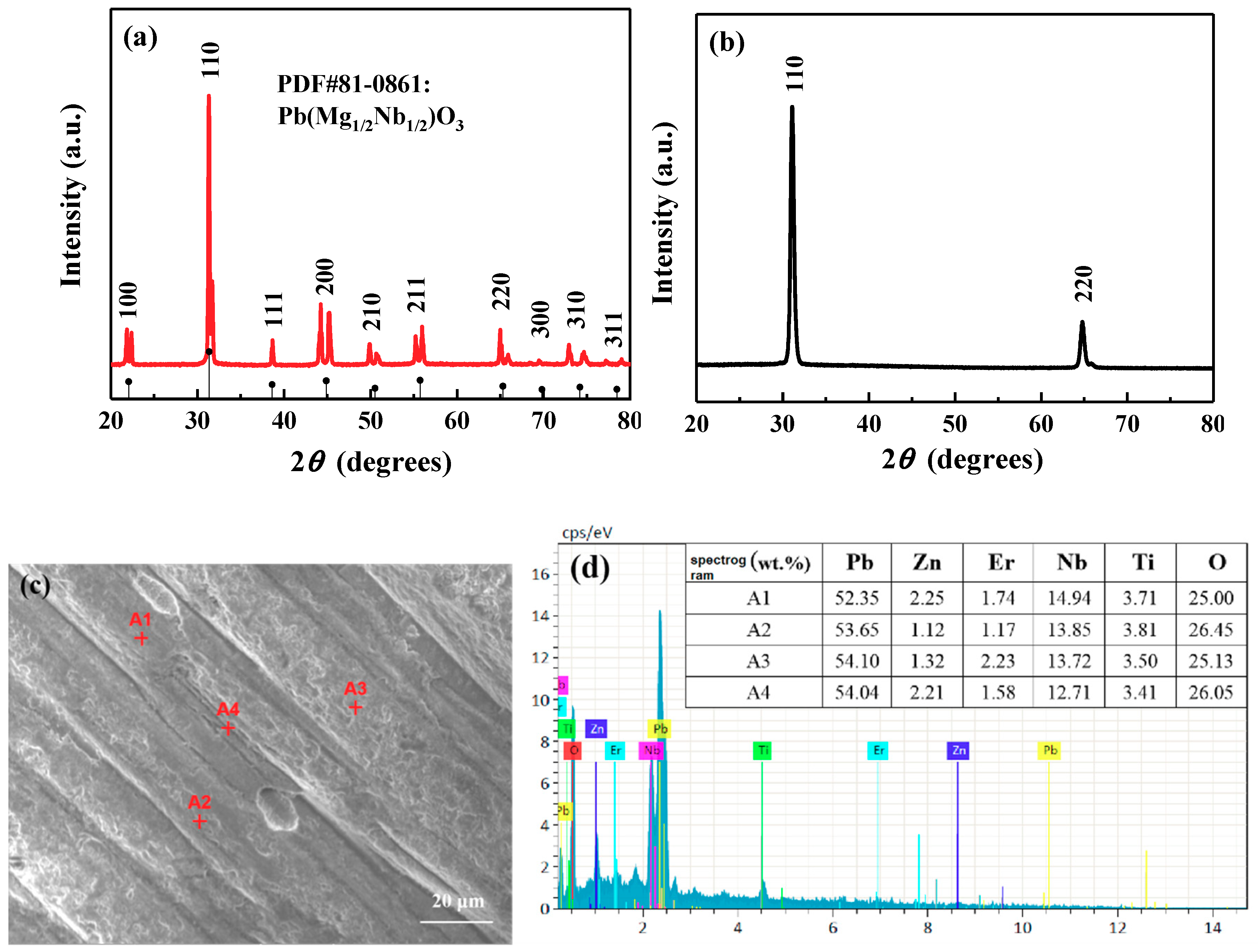
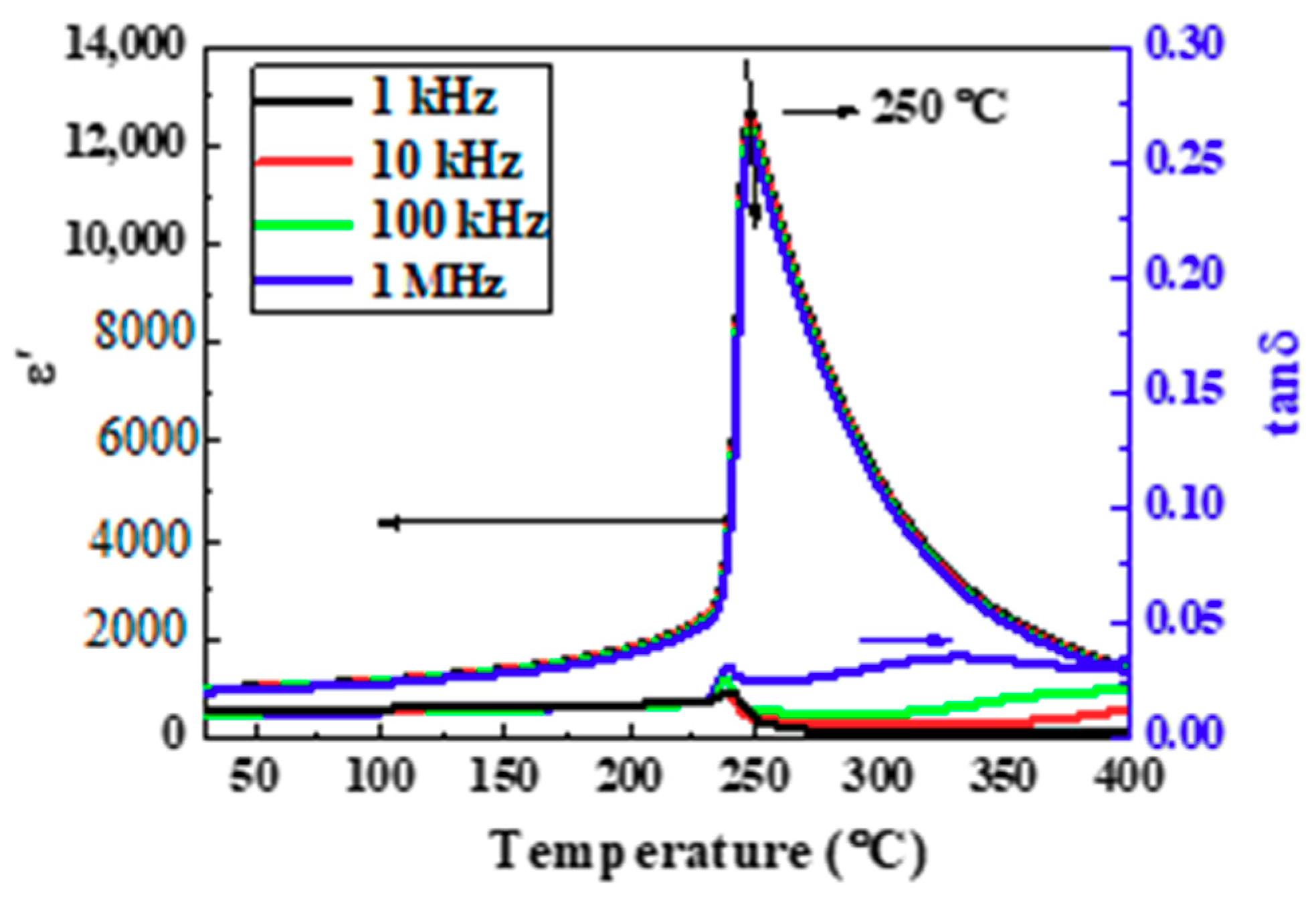
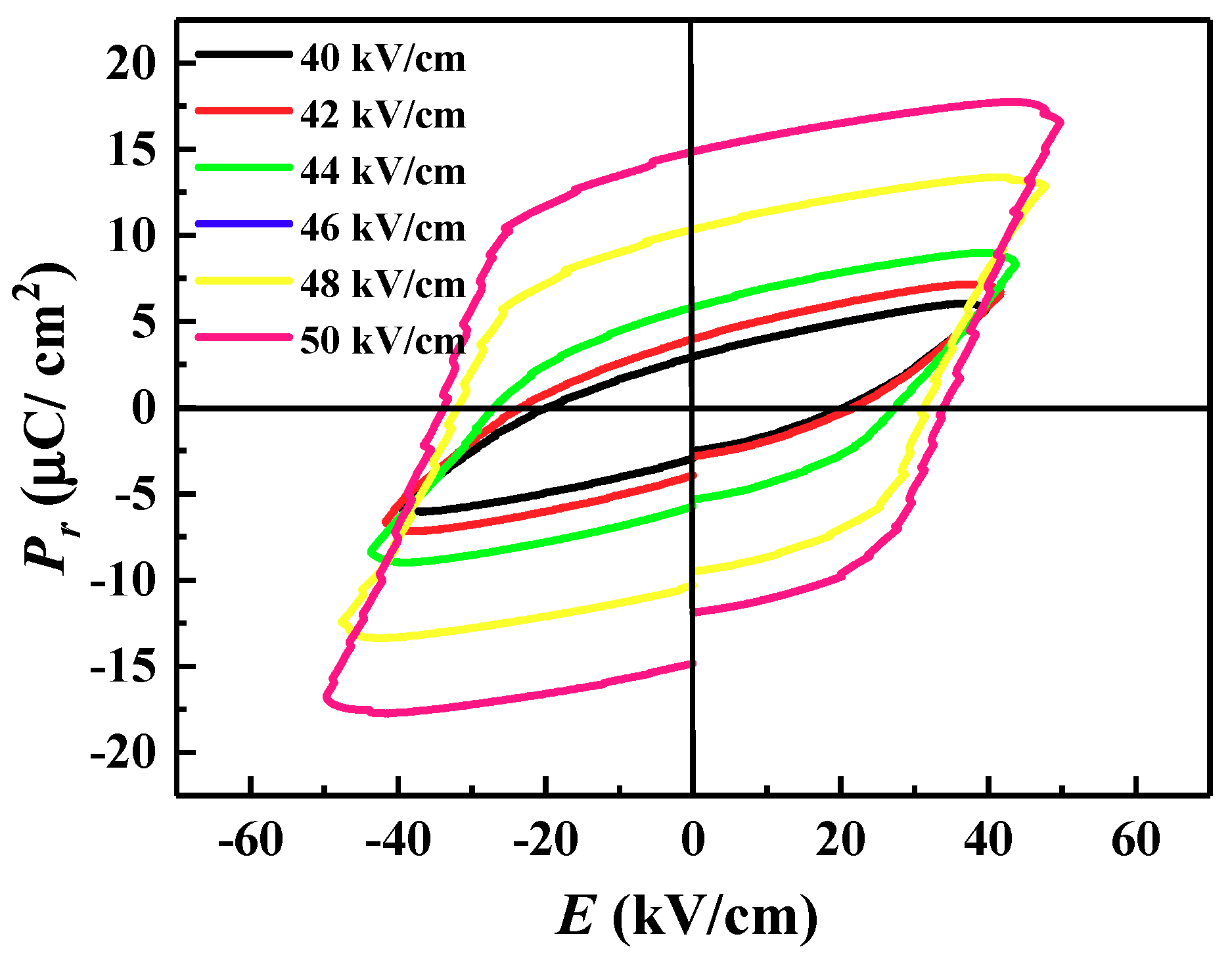
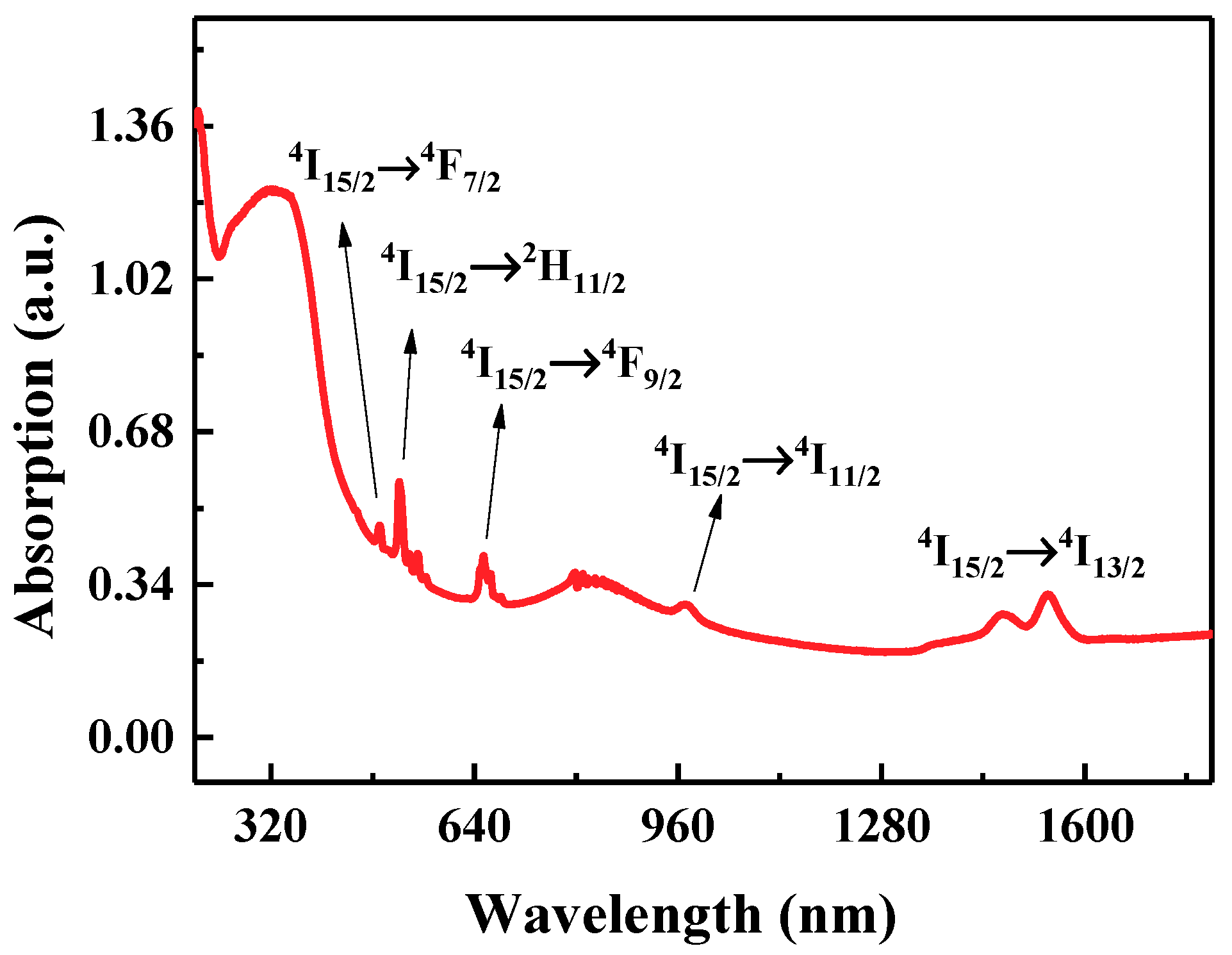
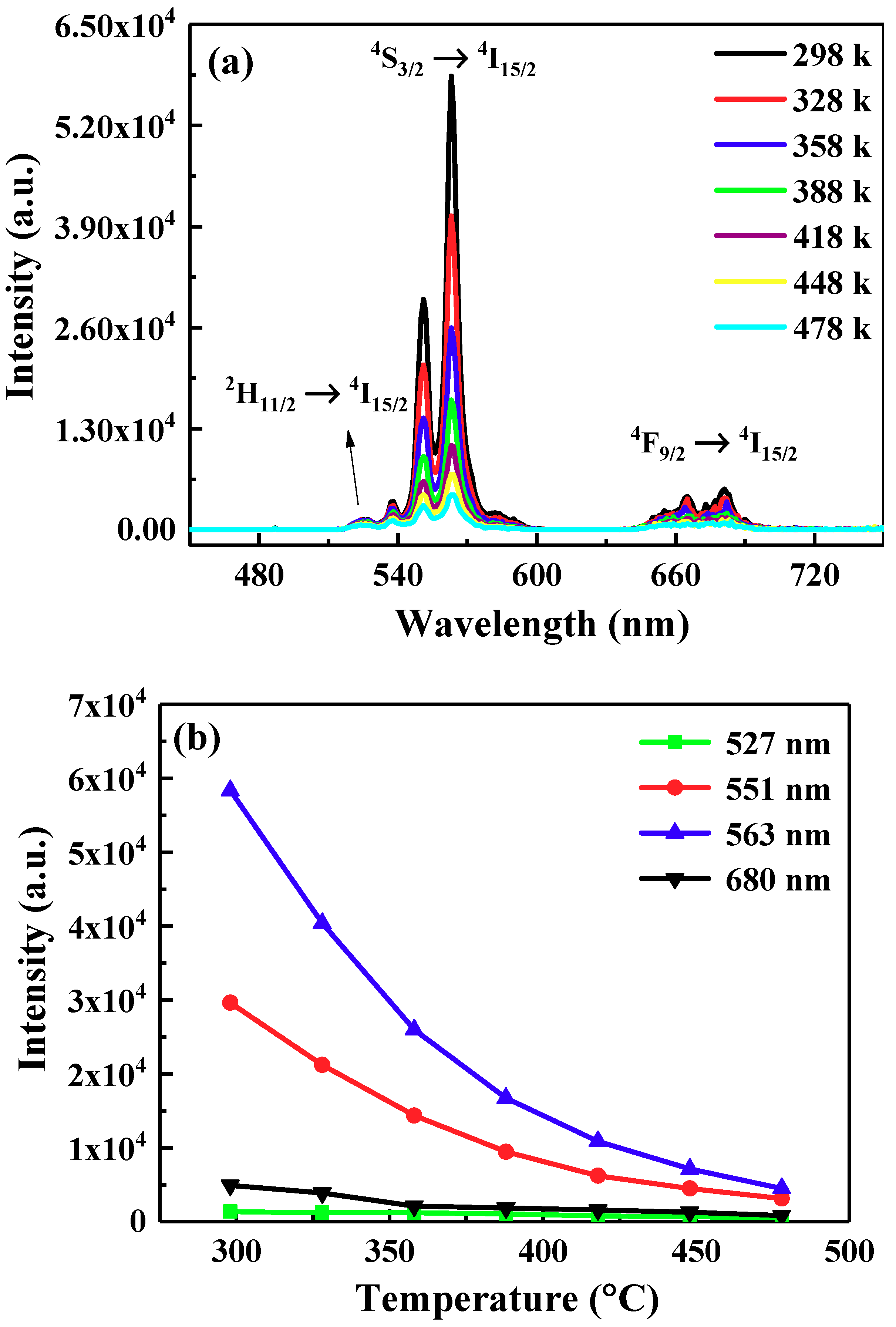
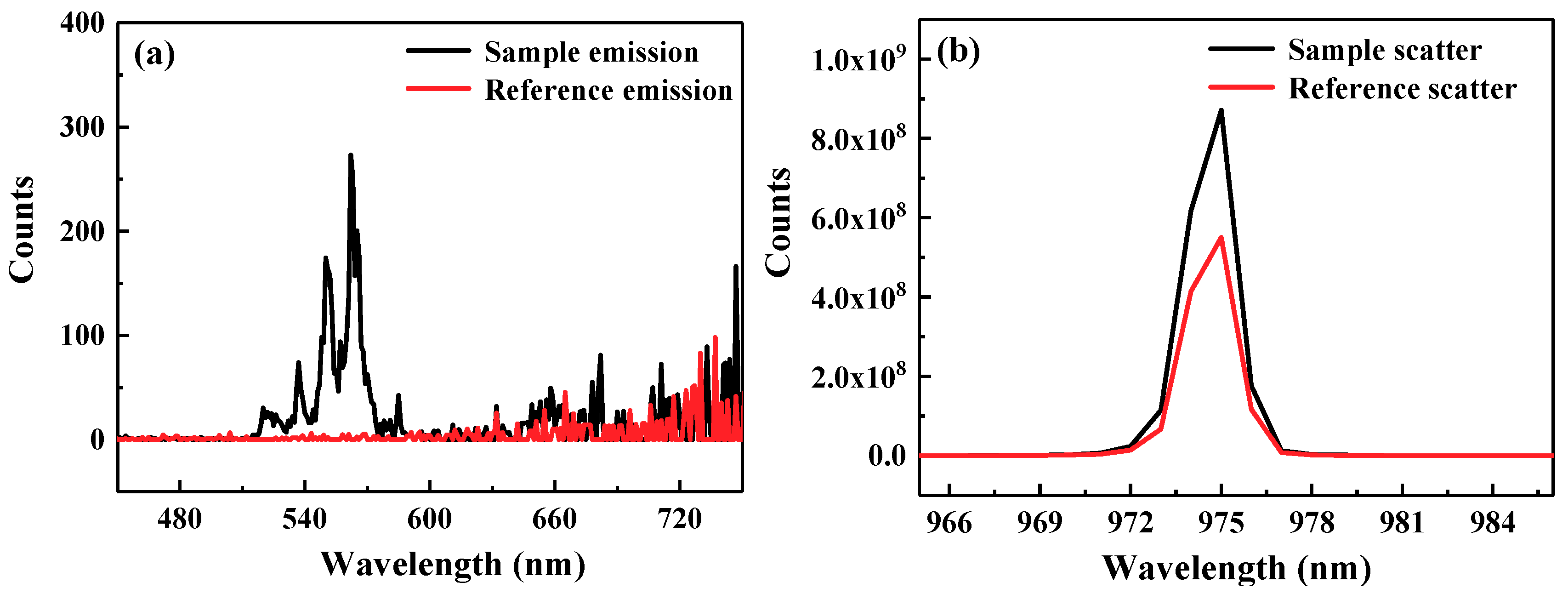
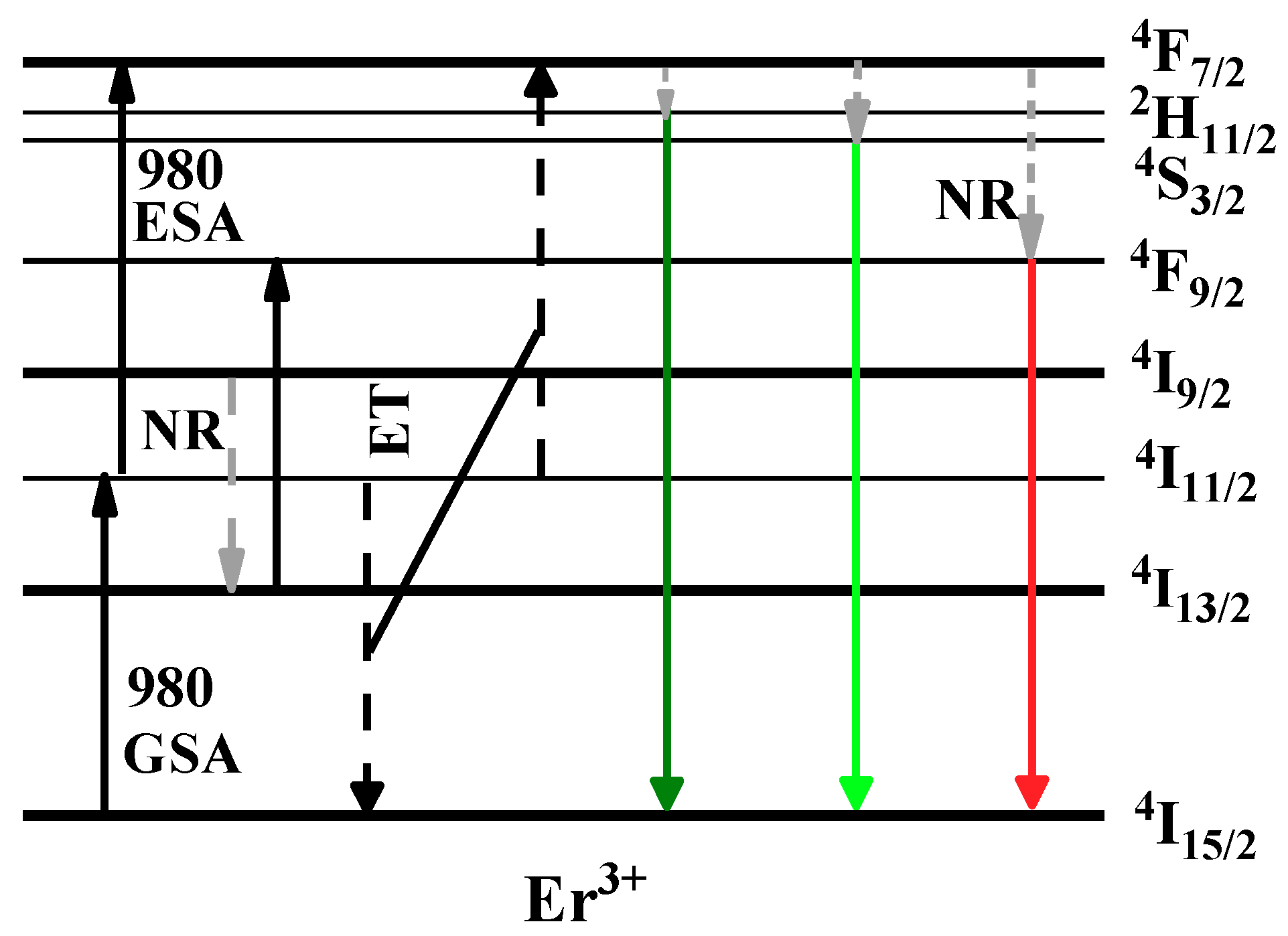
© 2020 by the authors. Licensee MDPI, Basel, Switzerland. This article is an open access article distributed under the terms and conditions of the Creative Commons Attribution (CC BY) license (http://creativecommons.org/licenses/by/4.0/).
Share and Cite
Chen, Y.; Xi, Z.; Guo, F.; Fang, P.; Li, X.; Long, W.; He, A.; Zhu, Q. Pb(Er1/2Nb1/2)O3–Pb(Zn1/3Nb2/3)O3–PbTiO3 Single Crystals with High Curie Temperature. Crystals 2020, 10, 22. https://doi.org/10.3390/cryst10010022
Chen Y, Xi Z, Guo F, Fang P, Li X, Long W, He A, Zhu Q. Pb(Er1/2Nb1/2)O3–Pb(Zn1/3Nb2/3)O3–PbTiO3 Single Crystals with High Curie Temperature. Crystals. 2020; 10(1):22. https://doi.org/10.3390/cryst10010022
Chicago/Turabian StyleChen, Yifei, Zengzhe Xi, Feifei Guo, Pinyang Fang, Xiaojuan Li, Wei Long, Aiguo He, and Qianlong Zhu. 2020. "Pb(Er1/2Nb1/2)O3–Pb(Zn1/3Nb2/3)O3–PbTiO3 Single Crystals with High Curie Temperature" Crystals 10, no. 1: 22. https://doi.org/10.3390/cryst10010022
APA StyleChen, Y., Xi, Z., Guo, F., Fang, P., Li, X., Long, W., He, A., & Zhu, Q. (2020). Pb(Er1/2Nb1/2)O3–Pb(Zn1/3Nb2/3)O3–PbTiO3 Single Crystals with High Curie Temperature. Crystals, 10(1), 22. https://doi.org/10.3390/cryst10010022




